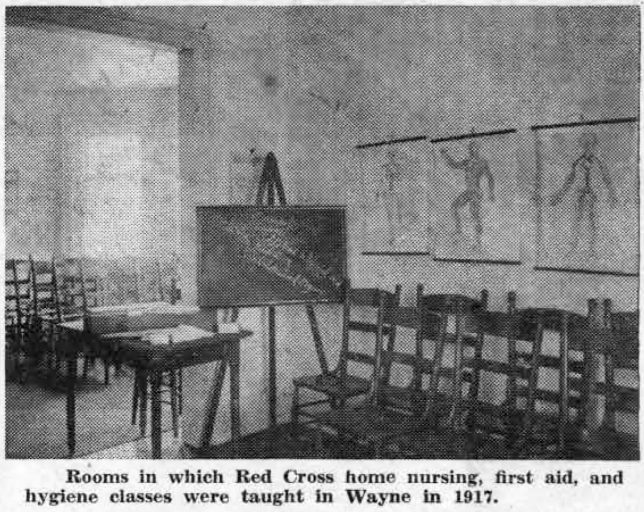 A perusal of the bound copies of “The Suburban” of some 40 years ago shows that even as early as 1916 and 1917, the first years of World War I, the home town paper carried each week a column of Wayne Red Cross information under the heading of “Red Cross Notes.” In concise and to the point paragraphs this column brought to the reading public the news on various classes being held at Wayne Branch Headquarters.
A perusal of the bound copies of “The Suburban” of some 40 years ago shows that even as early as 1916 and 1917, the first years of World War I, the home town paper carried each week a column of Wayne Red Cross information under the heading of “Red Cross Notes.” In concise and to the point paragraphs this column brought to the reading public the news on various classes being held at Wayne Branch Headquarters.
There were also items of other types of Red Cross news from time to time, none perhaps more interesting than the story of the big Philadelphia Red Cross parade as given in the column recently.
The above picture, recently brought to light in present Red Cross headquarters, is evidently that of two adjoining rooms, in which home nursing and probably also first aid were taught. There are three large medical charts on the wall, and notes on the blackboard which indicate that a class might have been in session shortly before the picture was taken.
It is interesting to try to connect this picture with a notice in the Red Cross column of January 12, 1917, in which announcement is made of a class in home nursing and hygiene, to be given at Red Cross headquarters. The instructor was Miss Nellie May Rennyson and the class was to be limited to 20 members. If enrollment exceeded that number, a second class would be formed for the evening of the same day, as the instructor was willing to “stay over.”
The titles of these lectures seem quite different from those of present day “home nursing” classes. The first was “Bacteria and their relation to health and sickness.” Among the others were “Causes and transmission of diseases, and quarantines,” “The house, the effect of furnishing and arrangement on health,” “Care of house, suggestions for weekly cleaning and laundry,” “Use of tea and coffee,” “The household medicine cabinet,” and “Poultices, Plasters and Compresses.”
By this time two “emergency” cases had been treated in the emergency first aid room, a picture of which was shown in last week’s column. The first was that of a sprained ankle, which was bandaged by Dr. C.W. Truxal, who was assisted by a local Red Cross volunteer. And, according to the “Notes,” “After this demonstration of the practical work of the Red Cross, the patient desired to become a member of the Branch at once.” The second casualty to be treated was that of a ruptured blood vessel, when Dr. Joseph Egbert was assisted by Mrs. William Henry Brooks, chairman of the local branch. So impressed was Dr. Egbert by the importance of Red Cross first aid that he immediately volunteered his services for the future.
Later, four classes in first aid were in progress with plans for a fifth one under way, an evening class for chauffeurs and mechanics. Instructors for these classes were Dr. Alexander H. O’Neal and Dr. Truxal with Mrs. Robert G. Wilson as chairman from the Red Cross branch.
By March, 1917, lack of sufficient room in the Red Cross headquarters, which had been located in the O’Neal house, forced a move to more spacious quarters, in the former Bonniwell house at 122 West Lancaster avenue. Here, activities filled each week day beginning from a group on Monday mornings working under Mrs. W.H. Lawton to cut out surgical shirts, to Saturday, when Mrs. Brooks, Branch chairman, was “on hand to welcome any child who may wish to work with her in the making and filling of comfort pillows.”
(To be continued)
